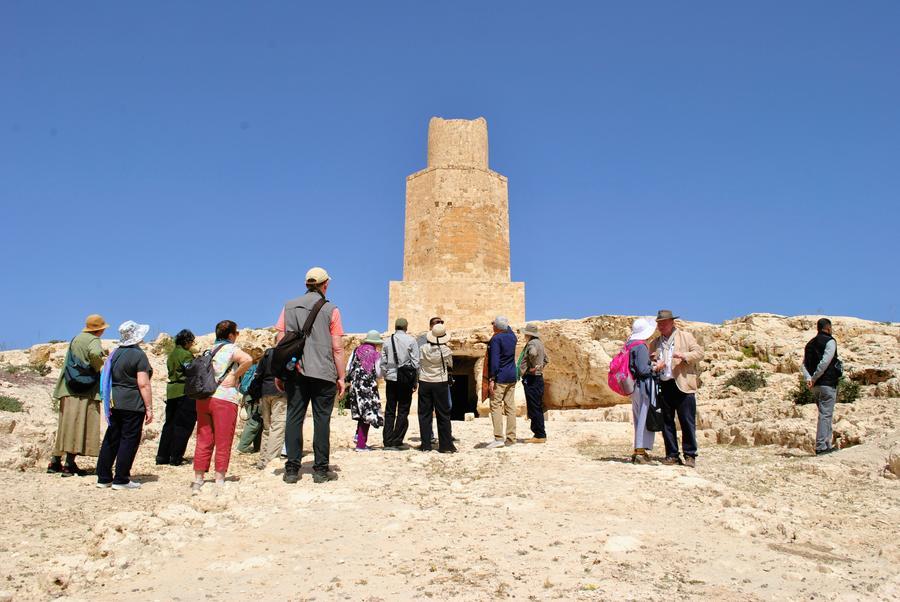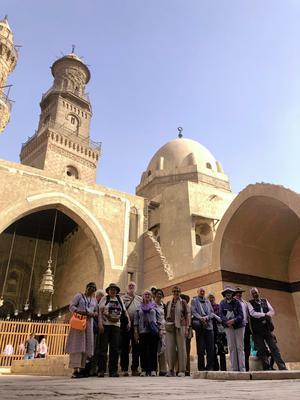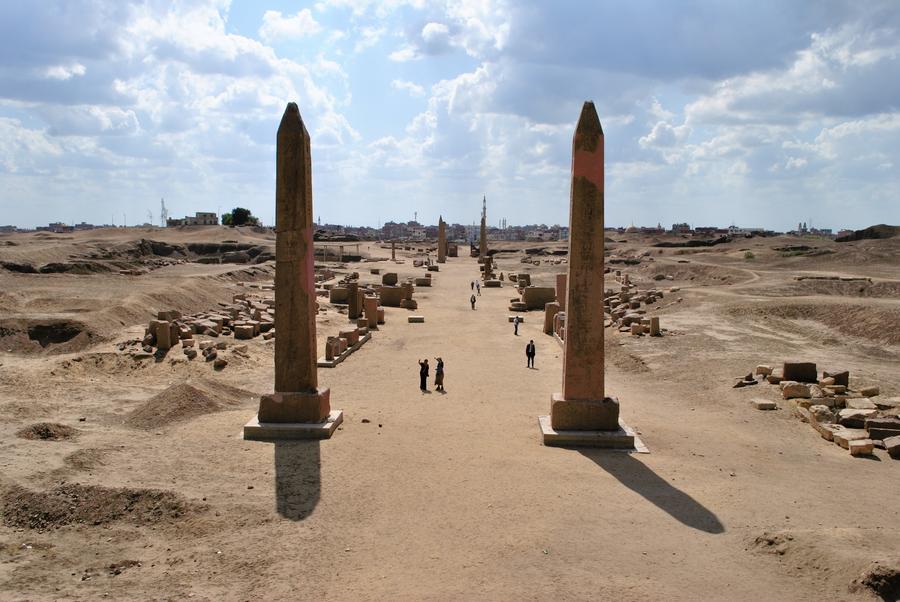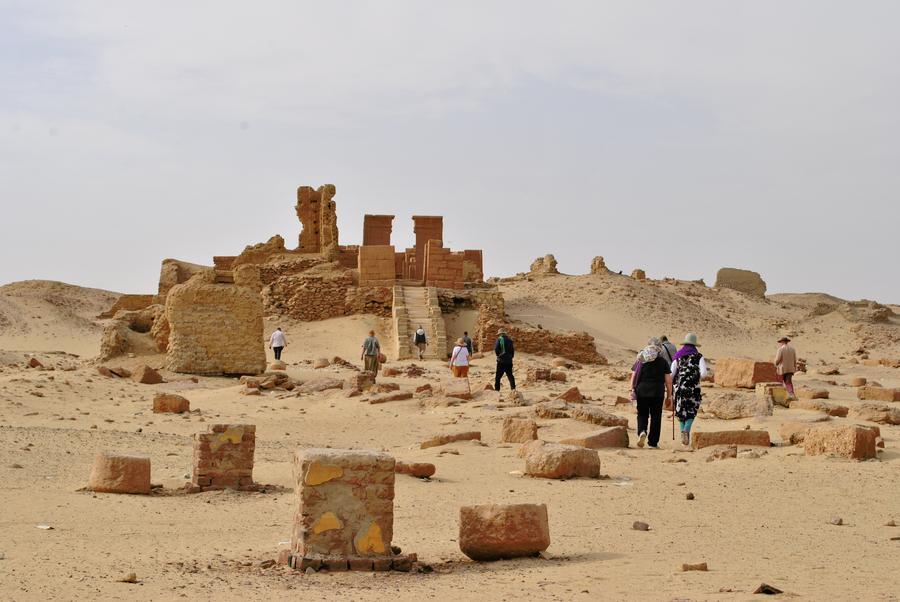EES Members explore Lower Egypt
Sitting here, writing this piece on a delayed train back in the UK, it is hard to believe that a few short weeks ago I was sitting by the banks of the Nile inhaling the sweet aroma of a cardamom spiced Egyptian coffee. Meanwhile, the thudding bass of a Cairo party boat disturbs the peace bestowed by the morning sun, awakening myself and our intrepid travellers to the busy schedule of site visits planned for the day.
Our goal for this adventure was to search for the ‘Lost Cities of Lower Egypt’. No, I didn’t intend for us to trek across open fields and tells in the Nile delta (that’s a job for our EES Delta Survey!), but instead to question what the concept of ‘lost’ really means and how we can reconstruct the past – as well as build a future – by considering what stands to be lost.

Our journey began on 28th March 2025 on the windswept northern coastline of Egypt’s vast delta at the somewhat sleepy fishing town of Rashid, findspot of the famous Rosetta Stone. Walking through Medieval (turned Napoleonic) forts and Ottoman villas, the interconnectedness of northern Egypt became clear. The non-Egyptian influence on culture, art, and architecture was even more apparent as the group continued west to Alexandria, capital of Egypt for almost a millennium. Founded by Alexander the Great after his conquest of Egypt in 332 BCE, the city’s earliest remains are now hidden beneath the modern sprawl of the country’s second-largest metropolis. However, tantalising hints at its ancient greatness remain and the group were able to visit the once monumental sites of the Serapeum and Lighthouse (now the fortress of Sultan Qaitbey), as well as descend into the darkness of the city’s catacombs. Together, we considered the hinterland of Alexandria by venturing even further west, across Lake Mariout, to Taposiris Magna (above), an impressive temple, cemetery, and settlement site dating back to the Ptolemaic Period. Occupying a strategic promontory between the lake and the Mediterranean, it was once a bustling trade centre with dramatic views across the northern coast but today stands in almost splendid isolation.

From Egypt’s once magnificent Hellenistic capital, we arrived in its current capital, Cairo. While we may not consider these places ‘lost’, the hidden histories beneath our feet are often out of reach. We traced the origins of Cairo from the Roman fortress of Babylon, often called Old Cairo or Coptic Cairo today. Here, where a canal to the Red Sea diverged from the Nile, a strategic centre was founded, perhaps during the Late Period. Its importance grew until, in 640 CE, Amr Ibn al-As besieged the town and brought Egypt under the rule of the Rashidun Caliphs based in Mecca. A new city was founded over the camp of Amr Ibn al-As called Fustat, and it was from here that Islam and the Arabic language were introduced to Egypt. Over time, the city spread, with new settlements founded to the north along the canal. One of these, founded by the amir Ahmad ibn Tulun in 868 CE was called Al-Qata’i, or ‘the quarters’. Not much remains of this city today as it was destroyed by the Abassid Caliphs of Baghdad just 35 years after its founding. The great mosque of Ibn Tulun remains on a rocky outcrop of the Mokkatam Hills. While we wandered through the streets of El-Khalifa, and northwards into Fatimid Qahirah (left) and the Khan el-Khalili, we were reminded that loss can take place in many ways – from natural processes to conflict, and even archaeology.
A detour northward from Cairo took us to some former EES excavated sites in the eastern delta at Tell Basta (ancient Bubastis) and San el-Hagar (ancient Tanis, below). Walking in the shadow of former excavators, Édouard Naville and William Matthew Flinders Petrie respectively, the work of current missions to protect these fragile sites was evident. As the wind swept across the expanse of mudbrick remains at Tanis, they forced a gap in the grey skies allowing the sun to pierce through and illuminate the tombs of Egypt’s 21st and 22nd Dynasty kings. The resurrection of monumental sculptures here offers a glimpse at the ghosts of past kings and queens, and mighty obelisks continue to extol their virtues from millennia past. Many of these, however, do not belong here. They were originally erected at the royal city of Ramesses II, Per-Ramesses, in the 19th Dynasty and later relocated to Tanis when the Pelusiac branch of the Nile silted up, making the earlier city uninhabitable. The earlier origin of these later cities was always in plain sight as the dramatic skies of the delta were brightened by the passing glimmer of iridescent green on the wings of bee-eaters flitting across the mudbrick palace of Amenemhat III at Bubastis, often forgotten by visitors contented by the granite block jigsaw of Bastet’s great templenearby.

Our final destination on the journey was the Faiyum, south of Cairo. The number of ‘lost’ places grew as we strode across the desert to the ruined remains of pyramids at Meidum, Lahun, Hawara (and its labyrinth), and el-Lisht, below. The last of these was a special permit visit, to what might be all that is left of the Middle Kingdom royal residence of (Amenemhat) Itj-Tawy. Though little remains today, hints of once beautifully carved decoration teased us from the sandy mounds surrounding the pyramids. Today, locals continue to bury their dead here – an echo of the past calling down to us from the ages.

Once in the Faiyum, the landscape changed dramatically. Fed by Nile waters from the Bahr Jusuf, irrigation remains an important part of daily life here. Sitting by the banks of the Birket Qarun, we could watch the winds that had been growing in intensity, as walls of sand accumulated over the lake basin. The thickness of the air and smell of dust hit us, suddenly, at the site of Tebtunis. Winds roared as sand grains exfoliated our faces. Rather than put off EES members, the group bristled with excitement… for at least the first ten minutes. The intensity of the wind increased. And then, nothing. Complete stillness. The sun broke through the beige air, banishing the wind in an instant. Before us, the mudbrick remains of Tebtunis spread across the plain, as clear as if there had been no storm at all. The ancient temples of Sobek and bathhouses, partially reconstructed, could be walked as if we had travelled back in time. We saw further temples to the crocodile god at Medinet Maadi and Karanis (below), our final stop. Here, at an open air museum, the monumental sculptures found at Kom Firas (ancient Shedet or Crocodilopolis, near Medinet Faiyum) have been relocated. Our old friends, Amenemhat III and the Ptolemies were here too, and we realised that we had been walking in their footsteps all along.

While we did not discover any new ‘lost’ places on our travels, I think we all left with a sense of what ‘lost’ really means and what stands to be ‘lost’ if conflict and climate change are allowed to affect what we already have. While things may seem lost to us, these places and ways of life are not lost to those that live with them and the memories of these places remain strong.
My greatest discovery on the trip was the amazing group that I travelled with. There were 14 EES members on this trip – some who had travelled with me before, and several who were new to the EES trips. Each one brought their knowledge, experience, generosity, and good humour with them and we had a wonderful time laughing our way around Lower Egypt. These trips would not be possible without the partnership of Ancient World Tours. Medhat, who has guided us through every trip so far, is a veritable fount of knowledge who can be thrown into any location or situation and guide as if it were his back garden (I know, we tested it!). Wael and Ahmed assisted throughout and always with a cheeky smile – where would we be without them?! Peter, brings both his personal experience and his wit to each trip brightening every early morning and entertaining into the evening. It is a real pleasure to travel with all of them and I cannot wait for the next EES adventure – Lost Cities of Upper Egypt in October 2026! Stay tuned for further details and tickets.
